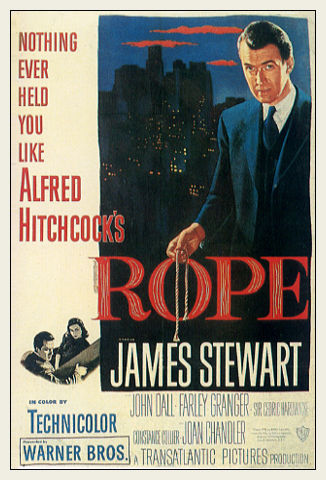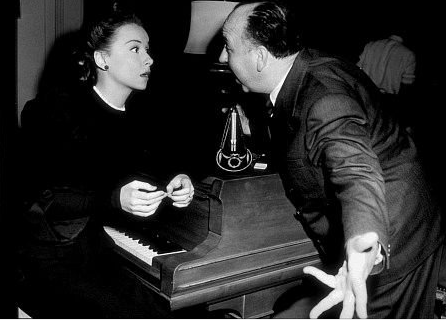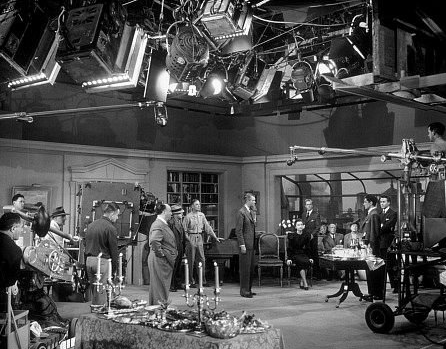
Defying all the rules of traditional cinema Hitchcock set out to make a a film that seemlessly flows to create the illusion of no editing. The end result makes the audience feel like they are watching a theatrical performance, a critic describes it as "... a fascinating experiment trying to find the cinematic equivalent to a play..." (Levy. E, 2005) No editing meant that the actors had no cuts between takes so they were basically acting out a play, but in front of a camera. The experiment works well for Hitchcock as he gives front row seats to witness the series of events unfolding in the apartment. The camera zooming and floating around the set creates a feeling of being a curious ghost following the actors every movements, even as they move from room to room in smooth gradual movements.
The continuous real time drags though out moments of the film especially when the camera lingers in the same spot for a couple of minutes for a conversation. However Hitchcock still manages to keep the audience entertained with the 'in jokes' in the cleverly written script about the body stashed in the trunk also a master at building suspense at close shaves of the secret being reviled. The suspense is at its highest when the maid is clearing the party food off of the trunk, done in one long continuous shot the audience can do nothing but sit and helplessly watch as she gets dangerously close to unveiling the secret. Knowing that the body is in the trunk from the beginning of the film is a simple but powerful way to create moments high tension, it makes it hard to keep your eyes off of the trunk.
"Constructed entirely from uncut ten-minute takes, shot on a beautifully-constructed set, it's certainly a virtuoso piece of technique, but the lack of cutting inevitably slows things down, entailing the camera swooping from one character to another during dialogues." (Andrew, G 2006) Because the camera can only shoot for 10 minutes at a time it becomes routine for the screen to have moments of darkness from disappearing behind the backs of the actors, which made the cuts obvious but still kept the flow of the film. Therefore the cuts don't make it entirely seamless editing, even other critics have commented: "...the camera trick of concluding every reel by focusing on some dark jacket or other transition surface becomes predictable..." (Lenin Imports, 2004) In consideration to Hitchcock's limitations of the 10 minute film this seems like the only way this film style could be pulled off without obvious jerky cuts.
For this film to work there must have been a lot of planning from the beginning, from the layout of the set as it was being built to the strain on the actors to remember there lines for long periods of time (no time for mistakes with colour film in the 1940's = $.)
 |
| Hitchcock and Joan Chandler, possibly arguing but Joan Chandler doesn't seem impressed. |
"Every movement of the camera and the actors was worked out first in sessions with a big blackboard, like football skull practice. Even the floor was marked and plotted with numbered circles for the 25 to 30 camera moves in each 10 minute reel. Whole walls of the apartment had to slide away to allow the camera to follow the actors through narrow doors, then swing back noiselessly to show a solid room. Even the furniture was "wild." Tables and chairs had to be pulled away by prop men, then set in place again by the time the camera returned to its original position, since the camera was on a special crane, not on tracks, and designed to roll through everything like a juggernaut."(Lenin Imports, 2004) Knowing that all this went on behind the scenes it is not so hard to spot if anything went wrong, from time the trunk had changed positions and the furniture in the kitchen had moved. However the actors performances were still to an exceptionally high standard and remained in character even under huge pressure of long periods of filming without a break, which inevitably caused problems between Hitchcock getting what wanted and the actors delivering it.
 |
| Behind the scenes snap shot of Rope (1948) It can be seen that the wall originally on the left has been removed for the placement of filming equipment for this scene. |
Source Image:
- Rope Film Poster - http://hitchcock.tv/mov/rope/rope.html
- Behind the Scenes of Rope- James Stewart, Alfred Hitchcock, and Cast on the set of "Rope." 1948 Warner http://www.imdb.com/media/rm476289024/tt0040746
- Hitchcock and Joan Chandler - "Rope," Joan Chandler and Director Alfred Hitchcock. 1948 Warner - http://www.imdb.com/media/rm4151810048/tt0040746
Bibliography:
- Andrew, G (2006) Time Out: Rope (1448). http://www.timeout.com/film/reviews/76944/rope.html (Accessed on the 12/02/2011)
- Lenin Imports (2004), Rope: Movie Review. http://www.leninimports.com/hitchcock_rope.html (Accessed on the 12/02/2011)
- Levy, E (2005). Rotten Tomatoes, Reveiws: All Critics. http://www.rottentomatoes.com/m/rope/ (Accessed on the 12/02/2011)

No comments:
Post a Comment